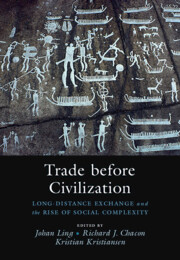14 results
Chapter Four - Bronze Age Long-Distance Exchange, Secret Societies, Rock Art, and the Supra Regional Interaction Hypothesis
- from Part I - Exchange and Social Evolution: Forms of Trade in Egalitarian, Transegalitarian, and Chiefdom Societies
-
-
- Book:
- Trade before Civilization
- Published online:
- 25 August 2022
- Print publication:
- 15 September 2022, pp 53-74
-
- Chapter
- Export citation
Contents
-
- Book:
- Trade before Civilization
- Published online:
- 25 August 2022
- Print publication:
- 15 September 2022, pp v-viii
-
- Chapter
- Export citation
Part IV - Marxian And Post-Colonial Approaches as well as World System Theory in Relation to Gift Exchange and MacroRegional Exchange
-
- Book:
- Trade before Civilization
- Published online:
- 25 August 2022
- Print publication:
- 15 September 2022, pp 287-382
-
- Chapter
- Export citation
Part II - The Role That Specific Institutions And Agents Played in Long-Distance Exchange
-
- Book:
- Trade before Civilization
- Published online:
- 25 August 2022
- Print publication:
- 15 September 2022, pp 107-206
-
- Chapter
- Export citation
Part I - Exchange and Social Evolution: Forms of Trade in Egalitarian, Transegalitarian, and Chiefdom Societies
-
- Book:
- Trade before Civilization
- Published online:
- 25 August 2022
- Print publication:
- 15 September 2022, pp 21-106
-
- Chapter
- Export citation
Index
-
- Book:
- Trade before Civilization
- Published online:
- 25 August 2022
- Print publication:
- 15 September 2022, pp 417-436
-
- Chapter
- Export citation
Part V - Commentary on Contributions to This Volume
-
- Book:
- Trade before Civilization
- Published online:
- 25 August 2022
- Print publication:
- 15 September 2022, pp 383-416
-
- Chapter
- Export citation
Chapter One - New Perspectives on Long-Distance Trade and Social Complexity
-
-
- Book:
- Trade before Civilization
- Published online:
- 25 August 2022
- Print publication:
- 15 September 2022, pp 1-20
-
- Chapter
- Export citation
Copyright page
-
- Book:
- Trade before Civilization
- Published online:
- 25 August 2022
- Print publication:
- 15 September 2022, pp iv-iv
-
- Chapter
- Export citation
Part III - The Role of Political Economy and Elite Control in Long-Distance Exchange
-
- Book:
- Trade before Civilization
- Published online:
- 25 August 2022
- Print publication:
- 15 September 2022, pp 207-286
-
- Chapter
- Export citation
Contributors
-
- Book:
- Trade before Civilization
- Published online:
- 25 August 2022
- Print publication:
- 15 September 2022, pp ix-x
-
- Chapter
- Export citation

Trade before Civilization
- Long Distance Exchange and the Rise of Social Complexity
-
- Published online:
- 25 August 2022
- Print publication:
- 15 September 2022
A Primer on Chiefs and Chiefdoms. TIMOTHY EARLE. 2021. Elliot Werner Publications, New York. 184 pp., $32.95 (paper), ISBN 978-1-7342818-3-5.
-
- Journal:
- Latin American Antiquity / Volume 32 / Issue 4 / December 2021
- Published online by Cambridge University Press:
- 15 November 2021, pp. 870-871
- Print publication:
- December 2021
-
- Article
- Export citation
Violent times: bioarchaeologies in the Americas - Debra L. Martin, Ryan P. Harrod & Ventura R. Pérez (ed.). The bioarchaeology of violence. xiv+291 pages, 42 illustrations, 21 tables. 2012. Gainesville (FL): University of Florida Press; 978-0-8130-4150-6 hardback $74.95. - Tiffiny Tung. Violence, ritual and the Wari empire. A social bioarchaeology of imperialism in the ancient Andes. xxiv+244 pages, 66 illustrations, 17 tables. 2012. Gainesville (FL): University of Florida Press; 978-0-8130-3767-7 hardback $74.95.
-
- Article
- Export citation



